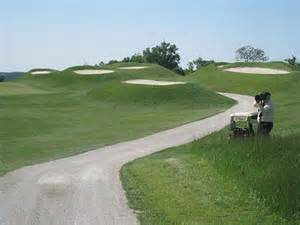Featured Golf News
Part 1 - How Deep Should Fairway Bunkers Be?
This is a tough question, in that:

Let's take a look at these factors individually.
Topography
As noted, bunkers need to fit the topography. I don't personally like to see the base of bunkers elevated several feet from natural grade of their base, as shown in the top photo.
Difficulty
Back when match play was common, a deep fairway bunker only cost one hole if it was impossible to recover. With stroke play now typical, deep bunkers taking five to six shots for some to recover can cause scoring disasters and slow play. Thus, fairways bunkers have generally become shallower, but there is nothing wrong with occasional exceptions.

Some general fairway bunker rules:
• Shallower than green-side bunkers;
• Shallower the further from the hole to accommodate long-iron recovery shots;
• Deeper on a par-5, where you can still reach the green in regulation even without a full shot out, and your penalty is only a longer iron into the green;
• On most par-4s, shallow enough to offer a good possibility of full recovery to the green.
Tour players won't challenge fairway bunkers unless they have at least a 2 to 1 chance of reaching the green from it. Otherwise, the chance of bogey statistically outweighs the chance for birdie too strongly. Thus, shallower bunkers actually provide less punishment, but more exciting golf; if too deep they're just a "stop sign" encouraging safe play to the other side of the fairway.

Golfers also prefer a lip steep enough to kick balls back away from the bunker edge to the center, to allow a full shot. The most critical part of the bunker is the face aiming right at the green. The back sides of bunkers can be steeper, and deeper, as a shot finding those areas is worse than one that just trickles in off the fairway.
The bottom photo shows a typical fairway bunker at La Costa Champions in California, which I helped redesign in 2011. If aiming directly at the green, there is little carry over a lip. On this uphill hole, with a mid-iron, it could be deeper on the flight line. However, it fits the existing hill behind it. The back slope and first few feet of the front of the bunker kick balls back to the middle for a fair and full-swing shot.
Jeffrey D. Brauer began his career as an apprentice in the Chicago area in 1977. His first project was Kemper Lakes, which shortly after hosted the 1989 PGA Championship. He formed GolfScapes in Arlington, Texas, in 1984. In the last 29 years he has designed and consulted on a wide spectrum of projects, ranging from partial renovations to international resorts. His recent work includes teaming with the design team of Pascuzzo and Pate on a remodel of the world-famous La Costa Resort & Spa in California, and renovations at Superior National Golf Course in Lutsen, Minn., and Mesquite Municipal Golf Course in Mesquite, Texas.
He has been a member of the American Society of Golf Course Architects since 1981, serving as President during its 50th Anniversary year in 1995-96. Jeff still studies the classic works - both old and new, and has played more than 75 of the best courses in the world.
Jeff gives many presentations and is a regular architecture columnist for many publications and websites, including Golf Course Industry and Cybergolf.com. He has also been a strong advocate for the "Tee it Forward" campaign and strives to make his courses fit the description of "fun to play every day."
Jeff's work has been spotlighted in most of the world's major golf magazines. Golf World ranked him as one of the top-20 golf course architects and Golf Inc. ranked him as the world's fourth-best value in golf architecture in 2010. Jeff's portfolio and reputation keep him at the forefront of desired designers for new courses, reconstruction and renovation projects. For more about Jeff, visit http://www.jeffreydbrauer.com/sites/courses/layout.asp?id=859&page=48451.
Story Options
 |
Print this Story |
